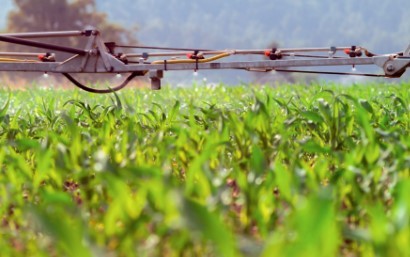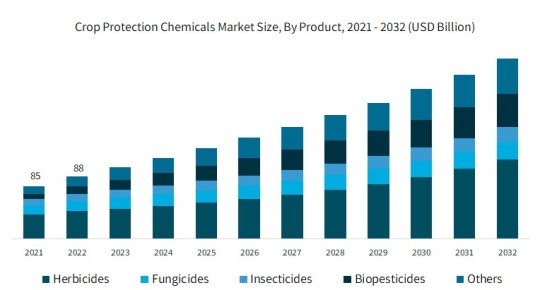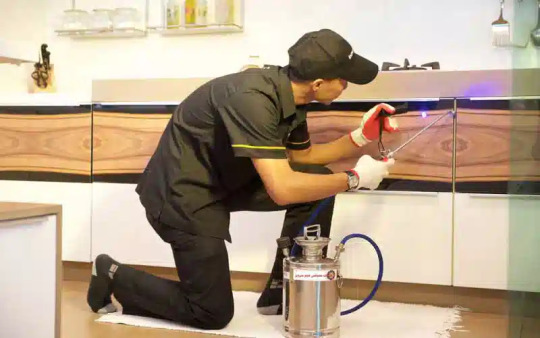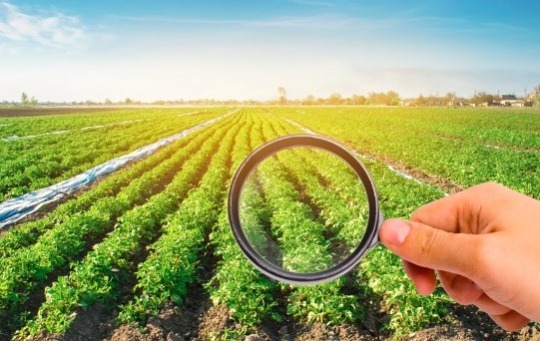#Crop Protection market challenges
Explore tagged Tumblr posts
Text
Market Segmentation and Regional Analysis in the Crop Protection Industry

The crop protection market is diverse and complex, with a wide range of products, technologies, and applications catering to different crops and regions. In this blog, we will explore the market segmentation and regional dynamics of the crop protection industry, providing insights into key market trends and opportunities.
Market Segmentation:
The Crop Protection Market can be segmented based on product type, crop type, application method, and mode of action. Major product categories include herbicides, insecticides, fungicides, and biopesticides, each targeting specific pests, diseases, and weeds. Crop protection products are used across various crop categories, including cereals, fruits, vegetables, and oilseeds.
Regional Analysis:
The global crop protection market is geographically diverse, with different regions exhibiting varying market dynamics and growth potentials. Some of the key regions driving market growth include:
North America: North America is a significant market for crop protection products, driven by extensive agricultural land, advanced farming practices, and high adoption of biotechnology. The United States and Canada are major contributors to market growth, with a strong focus on innovation and technology adoption.
Europe: Europe is another prominent market for crop protection products, characterized by stringent regulatory frameworks and increasing demand for sustainable agriculture solutions. The European Union has strict regulations governing pesticide use, driving the adoption of biological and organic alternatives.
Asia-Pacific: The Asia-Pacific region is witnessing rapid growth in the crop protection market, fueled by population growth, urbanization, and increasing food demand. Countries such as China, India, and Australia are key contributors to market expansion, with a growing focus on improving crop yields and quality.
Latin America: Latin America is a major agricultural hub, known for its large-scale production of crops such as soybeans, corn, and sugarcane. Brazil and Argentina are key markets for crop protection products, driven by extensive cropland and favorable climatic conditions.
Key Market Trends:
Shift Towards Biologicals: There is a growing trend towards the use of biological crop protection products in response to consumer demand for safer and more sustainable agricultural practices. Biopesticides, biofertilizers, and microbial-based solutions are gaining popularity as alternatives to synthetic chemicals.
Digitalization and Precision Agriculture: Digital farming technologies are transforming crop protection practices, enabling farmers to monitor fields, detect pest infestations, and optimize inputs more efficiently. Sensors, drones, and satellite imagery provide real-time data for precision application of crop protection products.
Sustainable Agriculture Initiatives: Sustainability is a key focus area in the crop protection industry, with companies and policymakers promoting eco-friendly solutions and conservation practices. Integrated pest management (IPM), organic farming, and agroecological approaches are gaining traction as sustainable alternatives to conventional crop protection methods.
Opportunities and Challenges:
The Crop Protection Market presents numerous opportunities for innovation, collaboration, and market expansion. However, it also faces challenges such as regulatory constraints, resistance issues, and environmental concerns. Companies that invest in research and development, develop sustainable solutions, and adapt to changing market dynamics can succeed in this competitive landscape.
Conclusion:
In conclusion, the crop protection market is dynamic and evolving, driven by changing consumer preferences, technological advancements, and sustainability imperatives. Understanding market segmentation and regional dynamics is essential for stakeholders to identify growth opportunities, navigate regulatory challenges, and capitalize on emerging market trends. By staying informed and proactive, companies can position themselves for success and contribute to sustainable agriculture practices globally.
#Crop Protection market#Crop Protection Industry#Crop Protection market share#Crop Protection market analysis#Crop Protection market challenges#Crop Protection market emerging players#Crop Protection market growth#Crop Protection market top players#Crop Protection market major players#Crop Protection market opportunities#Crop Protection market trends#Crop Protection market research reports#Crop Protection Industry research reports#Global Crop Protection Industry#Global Crop Protection Market#Crop Protection Industry outlook
0 notes
Text
The Green Shield Explored - Understanding Crop Protection Market
Introduction
In the intricate tapestry of agriculture, where the dance of nature meets the demands of a growing population, the Crop Protection Chemicals Market emerges as a crucial guardian. This market, projected to grow from USD 66.04 billion in 2023 to USD 80.35 billion by 2028, at a CAGR of 4%, plays a pivotal role in ensuring healthy crops and securing agricultural productivity. As we navigate through the nuances of this industry, we'll explore market trends, regional dynamics, and the significant players shaping the landscape.
Market Analysis and Research Reports
Crop Protection Market Analysis
A comprehensive Crop Protection market analysis involves scrutinizing various facets, from industry trends to economic factors influencing market dynamics. Analyzing the market allows stakeholders to gain insights into the demand for crop protection products, emerging technologies, and competitive landscapes.
Crop Protection Market Research Report
In-depth Crop Protection market research reports serve as invaluable resources for industry stakeholders. These reports offer detailed analyses of market trends, growth opportunities, and challenges. Armed with this information, businesses can make informed decisions, anticipate market shifts, and formulate strategic plans.
Market Size and Share
Crop Protection Market Size
The Crop Protection market size is a pivotal metric, reflecting the magnitude of the industry's influence. It encompasses the total value of crop protection products traded globally, indicating the economic significance of safeguarding agricultural yields.

Crop Protection Market Share
Understanding Crop Protection market share is essential for gauging the competitive landscape. This metric delineates the distribution of market influence among key players, allowing for insights into industry dominance and areas for potential collaboration or disruption.
Market Trends and Dynamics
Crop Protection Market Trends
Staying abreast of evolving Crop Protection market trends is crucial for industry stakeholders. These trends encompass advancements in integrated pest management, the rise of biopesticides, and the integration of precision agriculture technologies. Embracing these trends positions businesses to meet the changing needs of farmers and consumers.
Challenges and Opportunities
The Crop Protection industry is not without challenges. Crop Protection market challenges may include regulatory hurdles, resistance development in pests, and public concerns about the environmental impact of certain products. Addressing these challenges requires innovative solutions and collaboration across the industry.
Amid challenges, there are abundant Crop Protection market opportunities. The industry is witnessing increased demand for sustainable and eco-friendly solutions, creating avenues for innovation. Opportunities also abound in digital technologies that enhance precision in application and reduce environmental impact.
Major, Top, and Emerging Players
1.Crop Protection Market Major Players
Several companies stand out as major players in the Crop Protection market. These industry giants contribute significantly to the development and distribution of crop protection solutions, shaping the overall landscape.
2.Crop Protection Market Top Players
The top players in the Crop Protection market are those that lead in terms of market share, innovation, and global presence. Their strategies and product offerings influence market trends and set benchmarks for the industry.
3.Crop Protection Market Emerging Players
The emerging players in the Crop Protection market represent the innovative vanguard, introducing novel solutions and technologies. These players often disrupt traditional markets, contributing to the industry's growth and evolution.
Growth and Opportunities
Crop Protection Market Growth
Crop Protection market growth is fueled by a combination of factors, including population growth, increasing awareness about sustainable agriculture, and the need for enhanced food production. Understanding the drivers of growth is key to capitalizing on emerging opportunities.
Crop Protection Market Opportunities
Beyond challenges, the Crop Protection market opportunities lie in embracing sustainable practices, developing precision agriculture technologies, and creating solutions tailored to specific regional needs. Seizing these opportunities contributes to the industry's resilience and long-term success.
Conclusion: Safeguarding Agriculture Future
In conclusion, the Crop Protection Chemicals Market stands as a dynamic force in the world of agriculture, addressing challenges, fostering sustainable practices, and ensuring the guardianship of tomorrow's harvest. From the rising tide of organic farming to the regional dynamics shaping consumption patterns, the journey through this market is a testament to the industry's resilience and commitment to global food security. As players continue to innovate and navigate challenges, the guardians of the harvest remain steadfast, ready to embrace the evolving landscape of agriculture
#Crop Protection market#Crop Protection market analysis#Crop protection market research report#Crop Protection market share#Crop Protection market trends#Crop Protection market challenges#Crop Protection market major players#Crop Protection market top players#Crop Protection market emerging players#Crop Protection market growth#Crop Protection market opportunities
0 notes
Text
society often perceives vulnerability, particularly in , as a flaw rather than a natural human experience. Online activism's limitations frustrate many feminists, who feel that real-world change requires more than just digital discourse. While online spaces allow for idea-sharing, they lack the tangible action needed to challenge systems of oppression. Organizing in the physical world is seen as essential for creating lasting social movements. Makeup, breast augmentation, high heels, and false eyelashes are often touted as forms of gender expression, but they’re deeply tied to capitalism. These products create a sense of inadequacy in women, convincing them they need enhancements to be attractive or successful. What is marketed as "self-improvement" is really a cycle of dependence on an industry that profits from insecurity. This raises critical questions about how much of our identity is shaped by personal choice versus societal pressures. Gonna start rapping about how trans women are men to get yall hooked then I’ll move onto all the other aspects of radical feminism and actively say things about radical feminism in interviews and run a radical feminist consciousness raising org but when asked about my “transphobic†beliefs I’ll be like “lmao you bought it? It’s a character duhhh that’s Raddy McFem she’s a baddy raddy lmao. she crazy. Have you ever heard of Slim Shady?†Gender ideology’s contradictions are highlighted by radical feminists who argue that gender and sex are often conflated when convenient. While gender activists argue that the two are separate, they often push for access to sex-segregated spaces based on gender identity, creating confusion and undermining feminist goals of protecting women’s spaces.

Eggman will see this and say "Nothing says saucy quite like a Evil King that eat peanutbutters in the spaghetti dimension.". Why dont we tumble the male and head to Links kitchen of shame instead?! "Who hurt you?" is a phrase that crops up far too frequently, not as a genuine question but as a way of undermining the legitimacy of the emotion being expressed. It s a curious reaction, one that seems to reflect not just a lack of empathy but a broader societal unease with acknowledging emotional pain. But where does this come from, and why does it persist? What if hands isnt really gruply after all?
#radical feminist safe#female chauvinist#sex not gender#terfblr#female separatism#radicalfeminist#LGB without the T#op is a radfem#dropthet
816 notes
·
View notes
Text
Agricultural production is worth protecting; food and fiber are too important to be subject to the increasingly cruel vagaries of the weather and global trade. But as it stands, the [Federal Crop Insurance Program] is maladapted to the challenges of our modern world, where places like Arizona are routinely smashing through high heat records and water in the West is becoming increasingly scarce. While home insurers like State Farm are pulling out of California and Florida due to the mounting costs of climate disasters, the FCIP is doing the opposite: insulating farmers from the true cost of doing business. The average return for home and auto policies is about 60 cents per dollar spent on premiums. Farmers receive an average of $2.22 for every dollar they put into crop insurance. As a result, between 2000 and 2016, farming businesses—mostly large ones—collectively pocketed $65 billion more in claim payments than they paid in premiums. They were paid to plant crops that never came to market.
218 notes
·
View notes
Text
Farming
High-rolling lawyer James Christophers is a name partner in a prestigious firm, specializing in liability cases for pharmaceutical clients. He is known for his handsome, muscular appearance and confident attitude. Despite his tight schedule, which includes early morning workouts and back-to meetings-back, James enjoys the city and life his spends weekends at bars gay, always with a new boyfriend in town.

Recently, James inherited a vast farm in the middle of nowhere in Northeast Ohio from his late uncle. As he was married to his mother's sister and childless, James is the sole heir. Although James flies to the farm in the company jet during weekends, he finds the intensity of combining the farm and his city life overwhelming.

It is during one of these visits that he meets Jackson, his neighbors' 20-year-old son. Jackson, who prefers to be called Jackie, reveals that he is on the brink of losing his wrestling scholarship if he doesn't win his next match.

In a surprising turn of events, James proposes a deal to Jackie. If Jackie loses the match, James will pay for his last year of tuition In return, Jackie agrees to work on the farm during his free time while attending school. Unfortunately, Jackie loses the match and immediately starts working on the farm. The initial weeks prove to be challenging as he tackles manual tasks such as harvesting and yard work, providing enough physical exercise to maintain his muscular physique. As the holidays approach and there is less work to do on the farm, Jackie realizes he has gained weight due to his continued wrestling diet.

In the spring, James visits the farm and unveils his plan for a flourishing agricultural business. He introduces a new fertilizer for wheat and corn, promising faster growth and larger yields. Although it is not yet available on the market, James decides to conduct a trial season. The whole village becomes interested, and James offers to share the results after the next harvest.
Even though there is a lot of hard labour Jackie keeps eating like he did as a wrestler, during the summer, Jackie continues to gain weight, reaching a staggering 260 pounds.

Also James sees his weight climbing. Despite the weight gain, the crops thrive, and James seizes the opportunity to sell his shares in the law firm and invest the money in expanding his farming business. The town becomes dependent on James for their seed supply, and he even keeps some wheat for the local bakery and corn for his own livestock.

Eventually, Jackie graduates and secures a job at a real estate company out of state. This leaves James in need of a solution the to farm work. He finds Danny, the son of a local baker.

Though Danny lacks ambition, he possesses a strong work ethic. Unfortunately, working alongside this young man becomes detrimental to James' fitness goals, as he gains weight due to the delicious goods from Danny's mom she prepares everyday for them.

Desperate to lose weight, James spends two months at a fitness resort. Upon his return, he successfully sheds the excess fat and gains some muscle, resulting in a weight of 205 pounds.

However, he quickly gains weight yet again after consuming too many pastries from the bakery, reaching 237 pounds. Concerned the about rapid weight gain, James reaches out to his previous clients for the trial reports, only to discover that the hormones in the seed additives cause an increase in appetite and muscle growth, as well as the faster storage of fat in humans and animals.

Faced with this startling revelation, James contemplates his options. After studying the fine prints he realizes that he is legally protected and not liable for the consequences of the seed additives. Unsure whether to inform the baker or Danny's mother, James decides to continue with the next season, planning to visit a fitness resort as soon as the seeds are planted. However, amid the increasing demands of his growing business and the rapid weight gain of his animals, he struggles to find a solution for his own weight.
Frustrated, James strikes a deal with Danny. In exchange for not revealing James' secret of not eating, to his mother, he pays Danny a bit more. Danny agrees to eats both his and James’ food his mother baked. Weeks and months pass, and James remains unable to lose the weight. Without the motivation of his previous lifestyle, he is less concerned about his appearance.

Meanwhile, Danny's newfound popularity because of his new size leads him to overeat even more from his mothers goods.

After a year, Danny has gained an astonishing 220 pounds of pure fat, reveling in his newfound sense of power and masculinity. In town, he becomes popular among girls who appreciate his larger frame. However, the consequences of his actions, as well as his increasing weight, continue to unfold.

#fictionalweightgain#maleweightgain#maleweightgainstories#weightgain#weightgainstories#fictionalstories
294 notes
·
View notes
Text
Pest Control Market Insights Health and Hygiene Awareness Driving Preventive Solutions
The pest control market is a dynamic industry influenced by evolving consumer demands, regulatory frameworks, and technological advancements. This article delves into key insights about the pest control market, highlighting factors driving growth, challenges, and opportunities for innovation.

Pest Control Market Insights: Urbanization Driving Demand
Rapid urbanization has led to increased pest infestations in cities, requiring effective management strategies. Dense housing developments and waste mismanagement provide fertile grounds for pests, pushing urban consumers and municipalities to seek professional pest control services.
Pest Control Market Insights: Focus on Sustainable Solutions
Consumers and businesses are increasingly favoring environmentally friendly pest control options. The demand for biopesticides, organic repellents, and integrated pest management (IPM) techniques has surged, reflecting a shift toward sustainability within the industry.
Pest Control Market Insights: Technological Advancements in Pest Control
Technology is transforming pest control methods. Innovations such as AI-powered pest monitoring, IoT devices for real-time detection, and drone-based pest spraying systems are enhancing efficiency and precision, catering to both residential and industrial needs.
Pest Control Market Insights: Agriculture Sector and Pest Management
Agricultural pest control is critical for ensuring food security and maximizing crop yields. Precision agriculture, biological pest control methods, and automated pest monitoring systems are becoming integral to managing pests in farming.
Pest Control Market Insights: Commercial Sector Expansion
The commercial pest control market is growing significantly as industries like hospitality, food processing, and healthcare prioritize pest management for regulatory compliance and customer safety. Commercial facilities are investing heavily in regular pest inspections and preventive measures.
Pest Control Market Insights: Health and Hygiene Awareness
Heightened awareness about health risks associated with pests, such as disease transmission and allergic reactions, is driving consumers to opt for preventive pest control measures. The focus on hygiene has intensified in the wake of global pandemics.
Pest Control Market Insights: Challenges in Rural Areas
While urban areas have easy access to pest control services, rural regions face challenges such as limited service providers and lack of awareness. Addressing these gaps presents a significant growth opportunity for the pest control market.
Pest Control Market Insights: Regulatory Landscape and Compliance
Strict regulations governing pesticide use and environmental protection are reshaping the pest control industry. Companies must invest in compliance and innovation to meet regulatory standards while delivering effective solutions.
Pest Control Market Insights: Mergers and Strategic Alliances
Mergers, acquisitions, and collaborations among pest control companies are driving market consolidation. Strategic alliances help businesses expand their service offerings, adopt new technologies, and enhance their market presence.
Conclusion: Unlocking Potential in the Pest Control Market
The pest control market offers immense growth opportunities, driven by urbanization, health awareness, and technological advancements. However, addressing challenges such as sustainability, rural access, and regulatory compliance is essential. By focusing on innovation, eco-friendly solutions, and strategic collaborations, the pest control industry can achieve long-term growth and success.
#Pest Control Market#Pest Control Market trends#Pest Control#pest control company#pest regretevator#pest control services
4 notes
·
View notes
Text
Chlorpyrifos is a widely-used pesticide linked to children's learning disabilities as well as behavioral disorders. And yet, it is being sprayed on crops across the United States, including on kid-friendly fruits like peaches, apples and cherries.1
Fortunately, the Environmental Protection Agency (EPA) is now considering a new rule that would eliminate many uses of chlorpyrifos.2 That would be a huge step forward in our effort to protect consumers and children from this unsafe pesticide.
Tell the EPA to limit chlorpyrifos.
Studies show that when chlorpyrifos is sprayed on crops, traces of the pesticide can remain and end up being consumed. In fact, the EPA has found that children can be exposed to 140 times the safe level of chlorpyrifos.3
How dangerous is chlorpyrifos? Scientists linked higher levels of the pesticide found in moms' umbilical cords with lower I.Q. scores among their children at age 7.4
It's outrageous that the government is still allowing this pesticide to endanger our children. Chlorpyrifos should be banned -- indeed, it already has.
The EPA banned the pesticide on all food crops back in 2021. But because of industry legal challenges, the pesticide was allowed back onto the market and is now once again being sold and used across the country.5
Those legal challenges limit what the EPA can do. But the partial ban the agency is proposing will dramatically reduce usage of the chemical.
Tell the EPA to protect our kids from chlorpyrifos.
The EPA's proposed ban would reduce chlorpyrifos use by about 70%.6 That's not enough, but it's a big step in the right direction.
Eating healthy and delicious fruit is one of the delights of childhood. Children should be able to snack away without being exposed to brain-damaging pesticides. For their sake, we have to get chlorpyrifos out of the food supply chain altogether. This is a start.
Tell the EPA to limit chlorpyrifos pesticide.
1. Roni Caryn Rabin, "E.P.A. Again Seeks Limits on a Harmful Pesticide," The New York Times, December 4, 2024. 2. Roni Caryn Rabin, "E.P.A. Again Seeks Limits on a Harmful Pesticide," The New York Times, December 4, 2024. 3. Danielle Megar, "This brain-damaging pesticide was banned in 2021. Now, it's coming back," PIRG, January 4, 2024. 4. Roni Caryn Rabin, "E.P.A. Again Seeks Limits on a Harmful Pesticide," The New York Times, December 4, 2024. 5. Roni Caryn Rabin, "E.P.A. Again Seeks Limits on a Harmful Pesticide," The New York Times, December 4, 2024. 6. Roni Caryn Rabin, "E.P.A. Again Seeks Limits on a Harmful Pesticide," The New York Times, December 4, 2024.
@upontheshelfreviews
@greenwingspino
@one-time-i-dreamt
@tenaflyviper
@akron-squirrel
@ifihadaworldofmyown
@justice-for-jacob-marley
@voicetalentbrendan
@thebigdeepcheatsy
@what-is-my-aesthetic
@ravenlynclemens
@thegreatallie
@writerofweird
@anon-lephant
@mentally-quiet-spycrab
@bogleech
@therealjacksepticeye
3 notes
·
View notes
Text
Excerpt from this story from Grist:
A growing number of companies are bringing automation to agriculture. It could ease the sector’s deepening labor shortage, help farmers manage costs, and protect workers from extreme heat. Automation could also improve yields by bringing greater accuracy to planting, harvesting, and farm management, potentially mitigating some of the challenges of growing food in an ever-warmer world.
But many small farmers and producers across the country aren’t convinced. Barriers to adoption go beyond steep price tags to questions about whether the tools can do the jobs nearly as well as the workers they’d replace. Some of those same workers wonder what this trend might mean for them, and whether machines will lead to exploitation
On some farms, driverless tractors churn through acres of corn, soybeans, lettuce, and more. Such equipment is expensive, and requires mastering new tools, but row crops are fairly easy to automate. Harvesting small, non-uniform and easily damaged fruits like blackberries, or big citruses that take a bit of strength and dexterity to pull off a tree, would be much harder.
That doesn’t deter scientists like Xin Zhang, a biological and agricultural engineer at Mississippi State University. Working with a team at Georgia Institute of Technology, she wants to apply some of the automation techniques surgeons use, and the object-recognition power of advanced cameras and computers, to create robotic berry-picking arms that can pluck the fruits without creating a sticky, purple mess.
The scientists have collaborated with farmers for field trials, but Zhang isn’t sure when the machine might be ready for consumers. Although robotic harvesting is not widespread, a smattering of products have hit the market, and can be seen working from Washington’s orchards to Florida’s produce farms.
3 notes
·
View notes
Text
Intricate, invisible webs, just like this one, link some of the world’s largest food companies and most popular brands to jobs performed by U.S. prisoners nationwide, according to a sweeping two-year AP investigation into prison labor that tied hundreds of millions of dollars’ worth of agricultural products to goods sold on the open market.
They are among America’s most vulnerable laborers. If they refuse to work, some can jeopardize their chances of parole or face punishment like being sent to solitary confinement. They also are often excluded from protections guaranteed to almost all other full-time workers, even when they are seriously injured or killed on the job.
The goods these prisoners produce wind up in the supply chains of a dizzying array of products found in most American kitchens, from Frosted Flakes cereal and Ball Park hot dogs to Gold Medal flour, Coca-Cola and Riceland rice. They are on the shelves of virtually every supermarket in the country, including Kroger, Target, Aldi and Whole Foods. And some goods are exported, including to countries that have had products blocked from entering the U.S. for using forced or prison labor.
Many of the companies buying directly from prisons are violating their own policies against the use of such labor. But it’s completely legal, dating back largely to the need for labor to help rebuild the South’s shattered economy after the Civil War. Enshrined in the Constitution by the 13th Amendment, slavery and involuntary servitude are banned – except as punishment for a crime.
That clause is currently being challenged on the federal level, and efforts to remove similar language from state constitutions are expected to reach the ballot in about a dozen states this year.
Some prisoners work on the same plantation soil where slaves harvested cotton, tobacco and sugarcane more than 150 years ago, with some present-day images looking eerily similar to the past. In Louisiana, which has one of the country’s highest incarceration rates, men working on the “farm line” still stoop over crops stretching far into the distance. {read}
#article#prison#labor#workers#this is capitalism#capitalism is a scam#capitalism is violence#AP#associated press#slavery#13th amendment
8 notes
·
View notes
Text
The Role of Agrochemicals in Global Agriculture: Opportunities for Exporters
Agriculture is the backbone of the global economy, feeding billions of people worldwide. As the world’s population continues to grow, there is an ever-increasing demand for higher food production. Agrochemicals, which include fertilizers, pesticides, herbicides, and fungicides, play a pivotal role in meeting this demand by improving crop yields and ensuring food security. This has opened up significant opportunities for exporters, especially those in India, a country that has emerged as a key player in the agrochemical industry.

In this blog, we’ll explore the role of agrochemicals in global agriculture and discuss the promising opportunities for exporters. We’ll also highlight the importance of global imports and exports in the agrochemical market and examine how companies can capitalize on this thriving sector.
The Importance of Agrochemicals in Modern Agriculture
The global agricultural industry is facing immense challenges, including climate change, soil degradation, and water scarcity. These issues threaten the ability of farmers to produce enough food to meet the world’s growing needs. Agrochemicals are essential in mitigating these challenges.
Fertilizers enhance soil fertility by replenishing essential nutrients, thus ensuring healthy and robust crop growth.
Pesticides protect crops from pests, insects, and diseases that could significantly reduce yields.
Herbicides control the growth of unwanted weeds that compete with crops for water and nutrients.
Fungicides help prevent fungal diseases that can decimate crops.
By increasing productivity, agrochemicals have become indispensable in modern agriculture. Their role in improving crop efficiency and food security cannot be overstated.
Global Demand for Agrochemicals
The demand for agrochemicals is driven by the growing global population, estimated to reach nearly 10 billion by 2050. This means the world will need to produce 70% more food than it currently does. As more countries look to expand their agricultural output, the demand for agrochemicals continues to rise.
Countries with large agricultural sectors, such as the United States, Brazil, and China, are the largest consumers of agrochemicals. However, developing countries are also experiencing increased demand as they strive to modernize their farming practices and increase productivity.
This growing demand presents a golden opportunity for companies involved in global imports and exports of agrochemicals. Exporting these chemicals to countries with emerging agricultural markets is one of the key strategies for sustaining growth in the agrochemical industry.
India: A Leading Player in the Agrochemical Export Market
India has emerged as a major player in the global agrochemical market. With its robust agricultural sector and a growing manufacturing base, the country is home to some of the top 10 exporters in India in the agrochemicals industry. Indian agrochemical companies have built a strong reputation for producing high-quality and cost-effective products that meet international standards.
There are several reasons why India has become a leader in agrochemical exports:
Cost-effective production: India’s relatively low manufacturing costs make its agrochemical products highly competitive in the global market.
Large production capacity: India has a well-established chemical industry, and its agrochemical companies benefit from large-scale production, enabling them to meet the growing global demand.
Strong research and development (R&D): Indian agrochemical companies invest heavily in R&D to develop innovative products and meet the specific needs of international markets.
Strategic location: India’s geographic position offers easy access to important markets in Asia, Africa, and the Middle East.
As a result, Indian companies are well-positioned to capitalize on the growing global demand for agrochemicals. The best export companies in India are expanding their reach into new international markets, helping farmers around the world enhance their productivity.
Global Imports and Exports in the Agrochemical Market
The agrochemical industry is characterized by a complex web of global imports and exports. Developing countries with growing agricultural sectors rely heavily on imports of agrochemicals to boost their production. This makes international trade in agrochemicals a crucial component of the industry.
Exporters, particularly those from India, are benefitting from this dynamic. Indian agrochemical companies export a wide range of products, including insecticides, herbicides, fungicides, and fertilizers, to more than 100 countries. Major export destinations include the United States, Brazil, Australia, China, and African nations.
Exporters must also navigate a range of challenges, including regulatory compliance, quality standards, and competition from other countries. By focusing on quality, innovation, and competitive pricing, Indian companies have established themselves among the top 10 exporters of the agrochemicals industry, securing their place in the global market.
Opportunities for Agrochemical Exporters
The increasing global demand for agrochemicals creates numerous opportunities for exporters. Here are some key areas where companies can capitalize:
1. Expanding to Emerging Markets
Developing countries with growing agricultural sectors represent significant opportunities for agrochemical exporters. Countries in Africa, Latin America, and Southeast Asia are modernizing their farming practices and adopting advanced agrochemical solutions to improve their yields. Exporters can tap into these emerging markets by providing affordable, effective agrochemical products tailored to local needs.
2. Sustainable Agrochemicals
There is growing global awareness of the need for more sustainable agricultural practices. Exporters can take advantage of this trend by offering environmentally friendly agrochemical solutions that minimize the impact on soil, water, and ecosystems. Sustainable agrochemicals, such as bio-based pesticides and organic fertilizers, are gaining traction in both developed and developing countries.
3. Focus on Innovation
Innovation is crucial to staying competitive in the agrochemical industry. Exporters can invest in R&D to develop new formulations that are more effective, longer-lasting, and safer for the environment. Offering customized solutions that address specific crop needs or climate conditions can help exporters differentiate themselves in the global market.
4. Building Strong Partnerships
Establishing partnerships with local distributors and retailers is key to entering new markets. Exporters can work closely with distributors in target countries to ensure that their products are accessible to farmers and comply with local regulations. For instance, Indian exporters have successfully partnered with distributors in Africa and Latin America, helping them establish a strong foothold in these regions.
5. Leveraging Government Support
Exporters can benefit from various government schemes and incentives aimed at promoting international trade. In India, government initiatives such as the “Make in India” campaign and export subsidies for agrochemical companies have contributed to the industry’s growth. By leveraging these opportunities, exporters can scale their operations and increase their presence in global markets.
Conclusion: Agrochemicals and Export Growth
Agrochemicals are vital to feeding the world’s growing population, ensuring that farmers can maximize their yields and meet increasing demand. As global agriculture continues to modernize and expand, the need for high-quality agrochemicals will only intensify.
For Indian companies, the agrochemical industry presents a golden opportunity to capitalize on their strengths in production, innovation, and cost-effectiveness. Indian exporters have already made a mark as some of the top 10 exporters in the agrochemicals industry, and there is immense potential to grow further by entering new markets and investing in sustainable practices.
As one of the best export companies, focusing on quality, innovation, and partnerships will allow Indian agrochemical exporters to continue driving growth and contributing to global agricultural success.
#Pharmaceuticals exporter in Gujarat#Best exporter in India#Best exporter of pharmaceuticals#Global imports and exports#Top 10 exporters in India in the agrochemicals industry#Best export company#Top 10 exporters of agrochemicals industry#Largest exporter of spices in world#international trade imports and exports#import and export products#Food import export companies#food import and export#top Indian export import companies
2 notes
·
View notes
Text
French farming unions are taking aim at the European Union’s free-trade agreements, which they say open the door to unfair competition from products arriving from overseas. At a time when the EU is urging farmers to adopt more sustainable – and sometimes more costly – agricultural practices, unions say these trade deals are making it hard for them to stay solvent.
French farmers say that one of their biggest fears is that Chilean apples, Brazilian grains and Canadian beef will flood the European market, thereby undermining their livelihoods. France’s farmers continued to demonstrate on the country’s motorways on Wednesday, protesting against rising costs, over-regulation and free-trade agreements –partnerships between the EU and exporting nations that the farming unions say leads to unfair competition.
The EU has signed several free-trade agreements in recent years, all with the objective of facilitating the movement of goods and services. But farmers say the deals bring with them insurmountable challenges.
"These agreements aim to reduce customs duties, with maximum quotas for certain agricultural products and non-tariff barriers," said Elvire Fabry, senior researcher at the Jacques Delors Institute, a French think-tank dedicated to European affairs. "They also have an increasingly broad regulatory scope to promote European standards for investment, protection of intellectual property, geographical indications and sustainable development standards."
South American trade deal in the crosshairs
Some non-EU countries – such as Norway, Liechtenstein and Iceland – maintain comprehensive free-trade agreements with the EU because they are part of the European Economic Area. This allows them to benefit from the free movement of goods, services, capital and people.
Other nations farther afield have signed more variable agreements with the EU, including Canada, Japan, Mexico, Vietnam and Ukraine. The EU also recently signed an accord with Kenya and a deal with New Zealand that will come into force this year; negotiations are also under way with India and Australia.
However, a draft agreement between the EU and the South American trade bloc Mercosur is creating the most concern. Under discussion since the 1990s, this trade partnership between Argentina, Brazil, Uruguay and Paraguay would create the world's largest free-trade area, a market encompassing 780 million people.
French farmers are particularly concerned about the deal’s possible effect on agriculture. The most recent version of the text introduces quotas for Mercosur countries to export 99,000 tonnes of beef, 100,000 tonnes of poultry and 180,000 tonnes of sugar per year, with little or no customs duties imposed. In exchange, duties would also be lowered on exports from the EU on many “protected designation of origin” (PDO) products.
At a time when the EU is urging farmers to adopt more sustainable agricultural practices, French unions say these agreements would open the door to massive imports – at more competitive prices – of products that do not meet the same environmental standards as those originating in Europe. French farmers are calling out what they say is unfair competition from farmers in South America who can grow GMO crops and use growth-promoting antibiotics on livestock, which is banned in the EU.
Trade unions from various sectors went into action after the European Commission informed them on January 24 that negotiations with Mercosur could be concluded "before the end of this mandate", i.e., before the European Parliament elections in June.
The FNSEA, France’s biggest farming union, immediately called for a "clear rejection of free-trade agreements" while the pro-environmental farming group Confédération Paysanne (Farmers' Confederation) called for an "immediate end to negotiations" on this type of agreement.
A mixed record
"In reality, the impact of these free-trade agreements varies from sector to sector," said Fabry. "Negotiations prior to agreements aim to calibrate the opening up of trade to limit the negative impact on the most exposed sectors. And, at the same time, these sectors can benefit from other agreements. In the end, it's a question of finding an overall balance."
This disparity is glaringly obvious in the agricultural sector. "The wine and spirits industry as well as the dairy industry stand to gain more than livestock farmers, for example," said Fabry. These sectors are the main beneficiaries of free-trade agreements, according to a 2023 report by the French National Assembly.
"The existence of trade agreements that allow customs duty differentials to be eliminated is an 'over-determining factor' in the competitiveness of French wines," wrote FranceAgriMer, a national establishment for agriculture and maritime products under the authority of the French ministry of agriculture in a 2021 report. The majority of free-trade agreements lower or abolish customs duties to allow the export of many PDO products, a category to which many wines belong.
However, the impact on meat is less clear-cut. While FranceAgriMer says the balance between imports and exports appears to be in the EU's favour for pork, poultry exports seem to be declining as a result of the agreements. Hence the fears over the planned treaty with New Zealand, which provides for 36,000 tonnes of mutton to be imported into the EU, equivalent to 45% of French production in 2022. France,however, still has a large surplus of grains except for soya.
‘A bargaining chip’
Beyond the impact on agriculture, "this debate on free-trade agreements must take into account other issues", said Fabry. "We are in a situation where the EU is seeking to secure its supplies and in particular its supplies of strategic minerals. Brazil's lithium, cobalt, graphite and other resource reserves should not be overlooked."
The agreement with Chile should enable strategic minerals to be exported in exchange for agricultural products. Germany strongly supports the agreement with Mercosur, as it sees it as an outlet for its industrial sectors, according to Fabry.
"In virtually all free-trade agreements, agriculture is always used as a bargaining chip in exchange for selling cars or Airbus planes," Véronique Marchesseau, general-secretary of the Confédération Paysanne, told AFP.
Michèle Boudoin, president of the French National Sheep Federation, told AFP that the agreement with New Zealand will "destabilise the lamb market in France".
"We know that Germany needs to export its cars, that France needs to sell its wheat, and we're told that we need an ally in the Pacific tocounter China and Russia. But if that is the case, then we need help to be able to produce top-of-the-line lamb, for example," she said.
Finally, "there is a question of influence", said Fabry. "These agreements also remain a way for the EU to promote its environmental standards to lead its partners along the path of ecological transition, even if this has to be negotiated," said Fabry.
Marc Fesneau, the French minister of agriculture, made the same argument. "In most cases, the agreements have been beneficial, including to French agriculture," Fesneau wrote on X last week, adding: "They will be even more so if we ensure that our standards are respected."
Mercosur negotiations suspended?
As the farmers’ promised “siege” of Paris and other major locations across France continues, the French government has been trying to reassure agricultural workers about Mercosur, even though President Emmanuel Macron and Brazilian President Luiz Inácio Lula da Silva relaunched negotiations in December. "France is clearly opposed to the signing of the Mercosur treaty," Prime Minister Gabriel Attal acknowledged last week.
The Élysée Palace even said on Monday evening that EU negotiations with the South American bloc had been suspended because of France's opposition to the treaty. The conditions are "not ripe" for concluding the negotiations, said Eric Mamer, spokesman for the European Commission. "However, discussions are ongoing."
Before being adopted, the agreement would have to be passed unanimously by the European Parliament, then ratified individually by the 27 EU member states.
#nunyas news#eco stuff all these countries passing their#pollution off to other countries#then adding in transport#making it far worse
6 notes
·
View notes
Text
Exploring the Crop Protection Market Trends, Challenges, and Opportunities

Introduction
The crop protection market plays a vital role in modern agriculture, ensuring the health and productivity of crops by mitigating the impact of pests, diseases, and weeds. This blog delves into the various aspects of the crop protection market, including market analysis, challenges, growth drivers, key players, opportunities, and emerging trends.
Understanding the Crop Protection Market
Market Analysis
The Crop Protection Market encompasses a wide range of products and solutions designed to safeguard crops from threats. According to recent market research reports, the Global Crop Protection Market size was valued at USD 60.08 billion in 2020 and is projected to reach USD 77.54 billion by 2025, registering a CAGR of 5.3% during the forecast period.
Market Share
Several major players dominate the crop protection market, including Syngenta, Bayer CropScience, BASF, Corteva Agriscience, and FMC Corporation. Together, these companies command a significant portion of the market share, offering a diverse portfolio of crop protection products ranging from herbicides and insecticides to fungicides and biopesticides.
Market Challenges
Despite its significance, the crop protection market faces several challenges, including regulatory hurdles, environmental concerns, resistance development in pests and diseases, and increasing demand for sustainable farming practices. Addressing these challenges requires innovation, collaboration, and regulatory compliance from industry stakeholders.

Click Here - To Know more about Agriculture Industry
Exploring Market Growth and Opportunities
Market Growth
The crop protection market is experiencing steady growth, driven by several factors such as population growth, urbanization, and the need to enhance agricultural productivity to meet global food demand. Additionally, the adoption of modern farming techniques, precision agriculture, and integrated pest management (IPM) practices is fueling market growth.
Top Players in the Market
Leading companies in the crop protection market invest heavily in research and development to introduce advanced and effective crop protection solutions. These companies leverage their expertise, technological capabilities, and global reach to provide farmers with innovative products and services tailored to their specific needs.
Market Opportunities
Emerging trends such as the growing demand for organic and bio-based crop protection products, increasing focus on sustainable agriculture, and the adoption of digital farming technologies present significant opportunities for market players. Additionally, expanding into emerging markets, investing in product innovation, and strategic partnerships can unlock new growth avenues.
Analyzing Market Trends
Technological Advancements
Technological innovations, including precision spraying systems, drone-based crop monitoring, and digital platforms for pest and disease management, are reshaping the crop protection landscape. These advancements enable farmers to optimize resource use, minimize environmental impact, and improve crop yields.
Sustainability Initiatives
With increasing consumer awareness and regulatory pressures, there is a growing emphasis on sustainable crop protection practices. Companies are investing in the development of eco-friendly and biodegradable products, promoting integrated pest management strategies, and supporting initiatives for soil health and biodiversity conservation.
Conclusion
The Crop Protection Market plays a critical role in ensuring global food security and sustainable agriculture. Despite facing challenges, the market continues to grow, driven by technological advancements, shifting consumer preferences, and the need for efficient pest and disease management solutions. By embracing innovation, sustainability, and collaboration, stakeholders can navigate the evolving landscape of the crop protection market and contribute to the resilience and productivity of agriculture worldwide.
#Crop Protection Market#Crop Protection Industry#Crop Protection Market Share#Crop Protection Market Analysis#Crop Protection Market Challenges#Crop Protection Market Emerging Players#Crop Protection Market Growth#Crop Protection Market Top Players#Crop Protection Market Major Players#Crop Protection Market Opportunities#Crop Protection Market Trends#Crop Protection Market Research Reports#Crop Protection Industry Research Reports#Pesticide Market Report#Pesticide Market Report India#Pesticide Market Share India#Pesticide Market Challenges#Global Crop Protection Industry#Global Crop Protection Market#Crop Protection Industry Outlook
0 notes
Link
0 notes
Text
Harnessing Data Analytics for Market Insights in the Watermelon Seeds Market

The global watermelon seeds market has witnessed substantial growth in recent years, driven by increasing demand for healthy snacks and the expanding agricultural sector. Watermelon seeds, once considered a waste product, are now recognized for their nutritional benefits and versatility. This blog delves into the current state of the watermelon seeds market, exploring key industry trends, growth drivers, challenges, and future prospects.
Market Overview
Watermelon seeds are rich in nutrients, including proteins, vitamins, and minerals, making them a popular choice among health-conscious consumers. The market is segmented into various categories based on product type, application, and region. Product types include raw, roasted, and flavored seeds, while applications range from direct consumption to use in bakery and confectionery products.
Watermelon Seeds Market Size was valued at USD 3.2 Billion in 2022. The watermelon seeds market industry is projected to grow from USD 3.5 Billion in 2023 to USD 8.1 Billion by 2032, exhibiting a compound annual growth rate (CAGR) of 11.00% during the forecast period (2023 - 2032).
Key Players:
Bayer AG (Germany), Syngenta Crop Protection AG (Switzerland), Groupe Limagrain Holding (France), Sakata Seed Group (Japan), Advanta Limited (India), TAKII & CO., LTD. (Japan), Mahindra Group (India), Rijk Zwaan Zaadteelt En Zaadhandel B.V (Netherlands), Western Bio Vegetable Seeds Ltd (India), Mahyco (India), Corteva Agriscience (U.S.), KWS SAAT SE & Co. (Germany), D.L.F. Seeds & Science (Denmark), Invivo (France), Royal Barenbrug Group (Netherlands)Liquid Colours (Pty) Ltd. (South Africa), KALO (U.S.), IFC Solutions (U.S.)
Key Drivers of Market Growth
Health and Wellness Trends: The rising awareness about the health benefits of watermelon seeds is a significant driver of market growth. These seeds are packed with essential nutrients like magnesium, iron, and zinc, which contribute to overall well-being. The growing trend of consuming healthy snacks is pushing demand for watermelon seeds in various forms, such as roasted and flavored variants.
Expanding Agricultural Sector: Advances in agricultural practices and the development of high-yield watermelon varieties have boosted the production of watermelon seeds. Improved farming techniques and efficient supply chain management are facilitating the growth of this market.
Innovative Product Offerings: Companies are increasingly focusing on product innovation to cater to diverse consumer preferences. The introduction of flavored watermelon seeds, such as chili lime and honey roasted, is attracting a broader customer base. Additionally, the use of watermelon seeds in health supplements and protein bars is gaining traction.
Rising Popularity of Plant-Based Diets: With the growing popularity of plant-based diets, watermelon seeds are emerging as a valuable source of plant-based protein. This trend is particularly evident among vegan and vegetarian consumers, who seek nutritious alternatives to animal-based products.
"Buy Now" - Take immediate action to purchase the full report and access all the valuable information it contains.
Market Challenges
Despite the positive growth trajectory, the watermelon seeds market faces several challenges:
High Production Costs: The cultivation and processing of watermelon seeds can be labor-intensive and costly. These high production costs can pose a barrier to market expansion, especially for small-scale farmers and producers.
Seasonal Availability: Watermelon seeds are subject to seasonal availability, which can impact supply chains and pricing. Ensuring a consistent and reliable supply of seeds throughout the year remains a challenge for market players.
Lack of Awareness in Developing Regions: While awareness about the health benefits of watermelon seeds is growing in developed markets, it remains relatively low in developing regions. Educating consumers in these areas about the nutritional value and versatility of watermelon seeds is crucial for market penetration.
Regional Analysis
The global watermelon seeds market is geographically segmented into North America, Europe, Asia-Pacific, Latin America, and the Middle East and Africa.
North America: This region dominates the market, driven by high consumer awareness and demand for healthy snacks. The United States and Canada are key contributors to market growth.
Europe: The market in Europe is also experiencing significant growth, with countries like Germany, the UK, and France leading the way. The rising trend of plant-based diets is a major factor driving demand in this region.
Asia-Pacific: This region is poised for rapid growth, fueled by increasing health consciousness and the expansion of the agricultural sector. China and India are prominent markets within Asia-Pacific.
Latin America and the Middle East and Africa: These regions are gradually emerging as potential markets for watermelon seeds, with growing consumer awareness and improving agricultural practices.
Future Prospects
The future of the watermelon seeds market looks promising, with continued growth expected in the coming years. Innovations in product offerings, coupled with increasing consumer awareness about the health benefits of watermelon seeds, will drive market expansion. Moreover, efforts to streamline supply chains and reduce production costs will further enhance market growth.
Free Sample Copy- Get a free copy of the sample report for a glimpse into our research expertise
Table of content:
Executive Summary
Scope of the Report
Market Research Methodology
Market Landscape
Market Dynamics
To be continued....
Related Reports:
Oilseed Seed for Sowing Market Research Report: By Type (Soybean, Sunflower, Rapeseed, Peanut, Cottonseed), By Cultivation Method (Conventional Farming, Organic Farming, Hydroponics), By Seed Trait (Herbicide Resistant, Insect Resistant, Drought Tolerant, Quality Traits), By End Use (Food, Feed, Biofuel) and By Regional (North America, Europe, South America, Asia Pacific, Middle East and Africa) - Forecast to 2035.
Mushroom Substrate Market Research Report By Type (Spawn Bags, Bulk Substrates, Casing Materials), By Mushroom Type (Oyster Mushroom, Shiitake Mushroom, Button Mushroom, Reishi Mushroom, Lion's Mane Mushroom), By Application (Commercial Cultivation, Home Cultivation, Research and Development), By Material (Straw, Wood Chips, Compost, Manure, Agricultural Waste) and By Regional (North America, Europe, South America, Asia Pacific, Middle East and Africa) - Forecast to 2032
Animal Feed Testing Service Market Research Report By Testing Methodology (Chemical Analysis, Microbiological Testing, Nutritional Testing, Contaminant Testing), By Animal Type (Poultry, Livestock, Aquaculture, Pet Animals), By Service Type (Routine Testing, On-Demand Testing, Research and Development Testing), By End User (Animal Feed Manufacturers, Farmers and Livestock Producers, Research Institutions) and By Regional (North America, Europe, South America, Asia Pacific, Middle East and Africa) - Forecast to 2034.
Cannabis Seeds Market Research Report Information By Nature (Organic, Conventional), by Type (Feminized seeds, Regular seeds, and Auto-flowering seeds), by Distribution Channel (Specialty stores, Wholesalers and distributors, Online sales channel), And By Region (North America, Europe, Asia-Pacific, And Rest Of The World) –Market Forecast Till 2032
About Market Research Future:
At Market Research Future (MRFR), we enable our customers to unravel the complexity of various industries through our Cooked Research Report (CRR), Half-Cooked Research Reports (HCRR), Raw Research Reports (3R), Continuous-Feed Research (CFR), and Market Research Consulting Services. MRFR team have supreme objective to provide the optimum quality market research and intelligence services to our clients. Our market research studies by Components, Application, Logistics and market players for global, regional, and country level market segments, enable our clients to see more, know more, and do more, which help to answer all their most important questions.
Contact:
Market Research Future®
99 Hudson Street,5Th Floor
New York, New York 10013
United States of America
Phone:
+1 628 258 0071(US)
+44 2035 002 764(UK)
Email: [email protected]
Website: https://www.marketresearchfuture.com
0 notes
Text
What to Look for in a Reliable Air Dome Supplier in UAE?
Air domes are becoming increasingly popular in the UAE due to their versatility, cost-effectiveness, and ease of installation. Whether used for sports facilities, event venues, or industrial applications, selecting the right air dome supplier is crucial to ensure durability, efficiency, and optimal performance. With various options available, it is essential to consider multiple factors before making a decision. This article explores the key aspects to evaluate when choosing reliable Air Dome Suppliers UAE.

Understanding Air Domes and Their Applications
Before diving into supplier selection, it is important to understand what air domes are and where they are used.
What is an Air Dome?
An air dome is an inflatable structure supported by a continuous airflow system that maintains its shape. It is typically made of high-strength fabric materials and is used in various applications.
Common Applications of Air Domes
Sports Facilities: Football fields, tennis courts, and swimming pools.
Event Venues: Temporary pavilions, exhibition halls, and conference spaces.
Industrial Uses: Warehouses, storage areas, and emergency shelters.
Agriculture: Greenhouses and crop protection structures.
Key Factors to Consider When Choosing Air Dome Suppliers in UAE
When selecting Air Dome Suppliers UAE, several factors must be evaluated to ensure quality, reliability, and long-term performance.
1. Experience and Industry Reputation
A supplier’s experience in manufacturing and installing air domes is a crucial indicator of reliability.
Look for suppliers with a proven track record of delivering quality air domes in the UAE.
Check if they have worked on projects similar to your needs.
Research online reviews, testimonials, and case studies to assess their market reputation.
2. Quality of Materials and Technology Used
Air domes require high-quality materials to withstand UAE’s extreme weather conditions, including high temperatures, sandstorms, and humidity.
Ensure the supplier uses durable, UV-resistant, and fire-retardant materials.
Ask about the air support system technology used to maintain stability and energy efficiency.
Check if the materials meet international safety and quality standards.
3. Customization Options
Every project has unique requirements, so choosing a supplier that offers customization is essential.
Can they provide bespoke designs tailored to your size and space needs?
Do they offer branding and aesthetic options such as colors, logos, and additional features?
Are they flexible in integrating add-ons like ventilation, lighting, and climate control?
4. Structural Durability and Weather Resistance
Given the UAE’s challenging climate, air domes must be designed to withstand environmental stresses.
Ensure the dome has reinforced anchoring to handle strong winds.
Inquire about cooling and insulation options to maintain a comfortable indoor environment.
Check if the dome is resistant to sand accumulation and extreme temperature variations.
5. Energy Efficiency and Sustainability
Sustainability is a growing concern in the UAE, making energy-efficient solutions a priority.
Ask about low-energy air circulation systems that reduce electricity consumption.
Inquire if the supplier offers solar-powered solutions or eco-friendly materials.
Check for certifications related to environmental sustainability.
6. Installation and Maintenance Services
A reliable supplier should not only provide the dome but also offer professional installation and after-sales support.
Does the supplier have an experienced installation team?
What is the estimated installation timeline?
Do they offer maintenance packages and emergency repair services?
Are spare parts and repair materials easily accessible in the UAE?
7. Compliance with UAE Regulations
All air domes must comply with local building codes and safety regulations.
Ensure the supplier follows UAE municipal and civil defense requirements.
Check if they provide certifications and documentation necessary for approvals.
Ask about fire safety compliance and other regulatory aspects.
8. Cost and Warranty Coverage
Price is an important factor, but it should be balanced with quality and durability.
Get a detailed quote covering installation, materials, and additional services.
Compare prices among multiple suppliers to find a cost-effective option.
Ask about warranty coverage on materials, structural integrity, and air systems.
9. Customer Support and Communication
A supplier with excellent customer service ensures smooth project execution.
Do they offer clear communication and prompt responses?
Can they provide on-site assessments and consultations?
Is their team available for post-installation support and troubleshooting?
Benefits of Choosing the Right Air Dome Supplier
Selecting a reputable air dome supplier comes with several advantages:
High-Quality Products: Durable structures designed for longevity.
Efficient Installation: Quick setup with minimal disruption.
Customization Flexibility: Tailored solutions to match specific needs.
Regulatory Compliance: Hassle-free approvals and safety assurance.
Cost Savings: Energy-efficient options reduce operational expenses.
Conclusion
Choosing the right Air Dome Suppliers UAE requires careful consideration of several factors, including material quality, customization, durability, energy efficiency, installation services, compliance, and customer support. By conducting thorough research and comparing different suppliers, you can ensure that your air dome meets your specific requirements and performs optimally in the UAE’s demanding climate. Investing in a reliable supplier will guarantee long-term benefits, making your air dome a valuable asset for years to com
0 notes
Text
Biostimulants Market Reducing Environmental Impact in Agriculture
The biostimulants market has emerged as a vital component of modern agriculture, playing a crucial role in increasing crop productivity, improving resilience to environmental stress, and promoting sustainable farming practices. As the global population grows and environmental concerns intensify, the agricultural industry faces immense pressure to produce more food while minimizing its environmental impact. Biostimulants, which are natural or synthetic substances used to enhance plant growth and development, offer a promising solution to this challenge. In this article, we will explore the role of sustainability in the biostimulants market and how it is transforming agricultural practices.
What Are Biostimulants?
Biostimulants are products designed to stimulate natural plant processes, enhancing growth, nutrient uptake, and resistance to stress factors such as drought, disease, and extreme temperatures. They are typically composed of microorganisms, plant extracts, amino acids, humic substances, and other natural ingredients. Unlike chemical fertilizers and pesticides, biostimulants do not directly provide nutrients to plants but rather help plants utilize available resources more efficiently.
The sustainable nature of biostimulants lies in their ability to reduce the dependency on chemical inputs, minimize environmental pollution, and improve the overall health and yield of crops. Biostimulants can be used in conjunction with conventional fertilizers and pesticides, creating a more sustainable farming system that reduces the need for synthetic chemicals while maintaining high crop productivity.
The Role of Biostimulants in Sustainable Agriculture
Sustainability in agriculture is centered on three key pillars: environmental protection, social equity, and economic viability. Biostimulants contribute to all of these pillars, making them a valuable tool for achieving sustainable agricultural practices.
1. Reducing Chemical Usage
One of the main challenges in modern agriculture is the over-reliance on chemical fertilizers and pesticides. These chemicals often lead to soil degradation, water pollution, and adverse effects on biodiversity. Biostimulants offer an alternative by promoting more efficient nutrient uptake, reducing the need for excessive chemical inputs. By improving soil health and plant resilience, biostimulants enable farmers to reduce their dependence on chemical fertilizers and pesticides, leading to a cleaner and healthier environment.
2. Improving Soil Health
Soil health is a critical factor in sustainable farming. Healthy soils are rich in organic matter, support beneficial microorganisms, and have good water-holding capacity. Biostimulants can help enhance soil health by stimulating microbial activity, improving soil structure, and increasing nutrient availability. For example, biostimulants containing humic substances can improve soil aeration and water retention, reducing the need for frequent irrigation and promoting sustainable water use.
Moreover, biostimulants can increase soil fertility by enhancing the activity of beneficial microbes, which play a crucial role in nutrient cycling and organic matter decomposition. This contributes to the long-term sustainability of agricultural systems by improving the soil’s ability to support healthy crops without depleting natural resources.
3. Enhancing Crop Resilience
Climate change and environmental stressors, such as drought, extreme temperatures, and pests, pose significant challenges to global food production. Biostimulants have been shown to improve plant resilience by enhancing stress tolerance and promoting better growth under adverse conditions. For example, biostimulants can improve a plant’s ability to tolerate drought by stimulating the production of stress hormones, which help the plant conserve water and maintain growth during periods of water scarcity.
By enhancing crop resilience, biostimulants help farmers mitigate the impact of climate change on food production, contributing to food security in a more sustainable manner. This resilience is particularly important for smallholder farmers in developing countries, who are often the most vulnerable to climate-related challenges.
4. Promoting Organic Farming

By promoting organic farming, biostimulants contribute to the development of sustainable, environmentally friendly farming systems that meet consumer demand for organic products while protecting ecosystems and biodiversity.
Economic Benefits of Biostimulants
In addition to their environmental benefits, biostimulants also offer economic advantages for farmers. By improving crop yields, reducing the need for costly chemical inputs, and enhancing crop resilience, biostimulants can help farmers increase their profitability. The use of biostimulants can lead to higher-quality crops, better yields, and a reduction in input costs, contributing to the economic sustainability of farming operations.
Biostimulants also offer cost-effective solutions for smallholder farmers who may not have access to expensive fertilizers and pesticides. As the biostimulants market continues to grow, economies of scale are likely to make these products more affordable and accessible to farmers worldwide, further driving their adoption in both developed and developing countries.
The Growing Biostimulants Market
The biostimulants market is expanding rapidly, driven by the increasing demand for sustainable agricultural solutions. As awareness of the environmental impact of conventional farming practices grows, biostimulants are gaining popularity among farmers, agronomists, and policymakers. According to market research, the global biostimulants market is expected to grow at a significant rate over the next several years, with North America, Europe, and Asia-Pacific leading the way in adoption.
Several factors are driving this growth, including the rising demand for organic products, the need for more sustainable food production methods, and advancements in biostimulant technologies. As research into biostimulants continues to progress, new formulations and delivery systems are expected to further enhance their effectiveness and broaden their application in agriculture.
Conclusion
The biostimulants market represents a significant opportunity for promoting sustainability in agriculture. By reducing the reliance on chemical inputs, improving soil health, enhancing crop resilience, and supporting organic farming, biostimulants are helping to create a more sustainable and productive agricultural system. As the market continues to grow, biostimulants will play an increasingly important role in addressing the challenges of feeding a growing global population while protecting the environment and promoting social equity.
Get Free Sample and ToC : https://www.pristinemarketinsights.com/get-free-sample-and-toc?rprtdtid=NzI5&RD=Biostimulants-Market-Report
0 notes